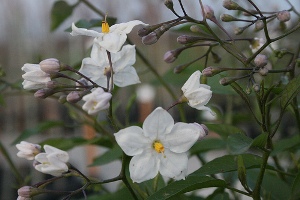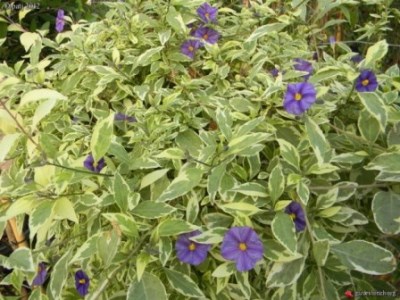 Lycianthes rantonnetii Condensed Version:
Lycianthes rantonnetii Condensed Version:
Lycianthes rantonnetii is a beautiful sprawling woody shrub which grows +-1.5 to 2.5m high with a 1.5 to 2m spread. In warm climates it is evergreen and can bloom almost all year round, but is most prolific during the warmer months. There are several garden cultivars with delicate flowers in shades of blue, violet, purple or white, with bright yellow centres. These versatile ornamentals are suited to most garden styles and situations and are cultivated in frost-free regions all over the world. Because these plants can be pruned into any shape, combined with their dense growth habit, makes them suitable as a hedge or informal screening plant. You can also grow them as a tree or standard plant by removing the lower branches. If only lightly pruned, their tumbling, drooping growth habit makes them ideal for creating an attractive and permanent backdrop for smaller shrubs and perennials.
These sprawling evergreens grow best in warm, moist, frost-free, summer rainfall regions of the country and will tolerate extreme heat and humidity. They are tender to frost but will tolerate light frost if planted in a protected position in the garden. In colder gardens they may lose leaves in winter. Although potato bushes love full sun, they can be planted in light shade; and in the winter rainfall and dry arid regions they will appreciate some shade during the day and regular watering. They grow well at the coast but must be protected from strong winds. These plants respond well to pruning and because they grow extremely fast, will require regular clipping and pinching in order to keep them bushy and compact. A light prune after main flower flushes will also encourage further flower production.They love full sun but will tolerate semi-shade. Potato bushes will grow in sandy, chalky soil but do best in the garden in well composted soil that drains well. Water regularly in summer, never allowing the soil to dry out totally, but take care not to overwater or this may impede flowering. Potato bushes grow best if fertilised regularly, so mulch the roots with compost twice a year, in spring and again in autumn, together with a slow release fertiliser. Potted plants respond well to feeding with a liquid fertiliser.
 Lycianthes rantonnetii 'Montreaux' Full Version:
Lycianthes rantonnetii 'Montreaux' Full Version:
Description, History & Interesting Facts:
These beautiful free-flowering ornamentals have been confused with the ightshades (Solanum) for a long time. They have now, however, been re-classified as Lycianthes rantonnetii. Lycianthes is apparently closely related to the chili peppers (Capsicum). The potato bush is one of about 150 species in the genus Lycianthes, which are found mostly in tropical regions of the Americas, and others located in the Asia-Pacific region.
Lycianthes rantonnetii is a sprawling woody shrub that comes from Argentina and Paraguay, and grows +-1.5 to 2.5m high with a 1.5 to 2m spread. In warm climates it is evergreen and can bloom almost all year round, but is most prolific during the warmer months. There are several garden cultivars with delicate flowers in shades of blue, violet, purple or white, with bright yellow centres. The flowers will attract butterflies to your garden, and, if left unpruned, the flowers are followed by small red fruits, which will attract birds to the garden.
(Lycianthes rantonnetii)
Lycianthes rantonnetii has purple flowers.
(Lycianthes rantonnetii ‘Montreaux’)
‘Montreaux’ has deep violet-blue flowers.
(Lycianthes rantonnetii 'White')
Has snow-white flowers.
(Lycianthes rantonnetii ‘Variegata’)
‘Variegata’ has lovely grey-green and cream leaves and mid-blue flowers.
 Lycianthes 'White'In the Garden:
Lycianthes 'White'In the Garden:
These versatile ornamentals are suited to most garden styles and situations and are cultivated in frost-free regions all over the world. The Royal Horticultural Society has given Lycianthes rantonnetii their prestigious Award of Garden Merit in 2012.
Because these plants can be pruned into any shape, combined with their dense growth habit, makes them suitable as a hedge or informal screening plant. You can also grow them as a tree or standard plant by removing the lower branches. Standard plants are great to use in small gardens and flowerbeds, and in large garden pots. When they are grown in this fashion, the growth points need to be pinched off very regularly to maintain the formal shape. This also ensures that they remain dense and lush with plenty of flowers.
If only lightly pruned, their tumbling, drooping growth habit makes them ideal for creating an attractive and permanent backdrop for smaller shrubs and perennials. Use them between other large shrubs in the background of a large bed, or in a row against a wire fence or palisade boundary, where their flowers and foliage will peep through, helping to soften their harsh lines.
Because all parts of these plants are poisonous, avoid growing them in areas where very young children play, as they may be tempted to put the bright red berries in their mouths.
 Lycianthes rantonetti 'Variegata' Picture courtesy www.kazimingi.co.zaCultivation/Propagation:
Lycianthes rantonetti 'Variegata' Picture courtesy www.kazimingi.co.zaCultivation/Propagation:
These sprawling evergreens grow best in warm, moist, frost-free, summer rainfall regions of the country and will tolerate extreme heat and humidity. They are tender to frost but will tolerate light frost if planted in a protected position in the garden. In colder gardens they may lose leaves in winter. Although potato bushes love full sun, they can be planted in light shade; and in the winter rainfall and dry arid regions they will appreciate some shade during the day and regular watering. They grow well at the coast but must be protected from strong winds. These plants respond well to pruning and because they grow extremely fast, will require regular clipping and pinching in order to keep them bushy and compact. A light prune after main flower flushes will also encourage further flower production.
They love full sun but will tolerate semi-shade. Potato bushes will grow in sandy, chalky soil but do best in the garden in well composted soil that drains well. Water regularly in summer, never allowing the soil to dry out totally, but take care not to overwater or this may impede flowering. Potato bushes grow best if fertilised regularly, so mulch the roots with compost twice a year, in spring and again in autumn, together with a slow release fertiliser. Potted plants respond well to feeding with a liquid fertiliser.
Propagate from tip or semi-hardwood cuttings in summer.
 Pests & Diseases:
Pests & Diseases:
Watch out for attacks from caterpillars, aphids and thrips. Other issues may include powdery mildew, grey mould, damping off, virus diseases, stem rot and blight.
Warning:
All parts of the Blue Potato Bush are poisonous and may cause severe stomach upset if eaten.


